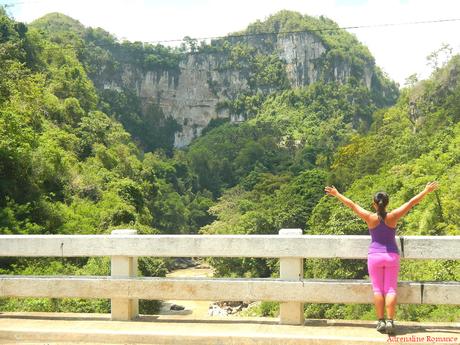
Succumbing to and overcoming the fear of heights is all a part of adventuring. If you wish to enter in into the world of adventure, sooner or later, you will have to face this challenge, from navigating slippery trails on mountainsides to climbing sheer rock walls. But let’s add something that makes the challenge more interesting—the opportunity to sleep on a tiny ledge hundreds of feet off the ground.
During a long ascent, rock climbers and mountaineers, sometimes need to spend the night on vertical cliffs. When they set camp on such rock walls, they have established a high-angle bivouac or simply vertical bivouac.
Now, Adventure Technology Outfitters, owned by marathoner Mark Battung and his wife Donna, and with the support of the local government of Quezon, Bukidnon, now offers this adrenaline-pumping vertical bivouac adventure, which is proudly the first of its kind in the Philippines! Now, we don’t need to the Half Dome in Yosemite in USA, Trango Towers in Pakistan, or Patagonia in South America. We have our own big wall right here right in our own beautiful province of Bukidnon in Mindanao!
Together with fellow blogger Tupe Diaz of Trekero, Sweetie and I were invited to try out this one-of-a-kind adventure. Oh, did we tell you that, except for Mark and his team, we were the first outsiders and “clients” who ever bivouaced on this huge wall? Wow, that’s definitely an honor!
After a good night’s sleep on board a Trans Asia ship, we arrived at the Cagayan de Oro port where Mark and his wife Donna were waiting for us. We were really excited in getting this extreme adventure underway.
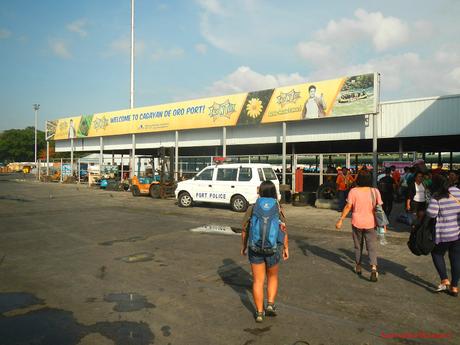
Mark and Donna turned out to be extremely good guides. They warmed us up by pointing out several potential high adventure sites while we drove all the way from Cagayan to Bukidnon. One of these sites is this very tall waterfall, which, by our estimates, is more than a hundred feet tall. See those pillar-like formations at one side of the pool? Each one is around 6 feet!
This waterfall is the end-point of a canyoneering route that Adventure Technology Outfitters is planning to establish.
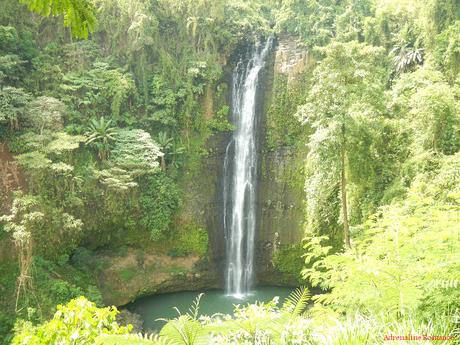
Nearing the city of Malaybalay, we stopped by this really tall bridge. Around a hundred feet high, the New Atugan Bridge is one of the highest inland bridges in the country. It is a great venue for bridge jumping and rappelling.

A strong, rushing river is nestled underneath the bridge. We’re not pretty sure about the lay of the river, but it seems to be a great candidate for river tubing.
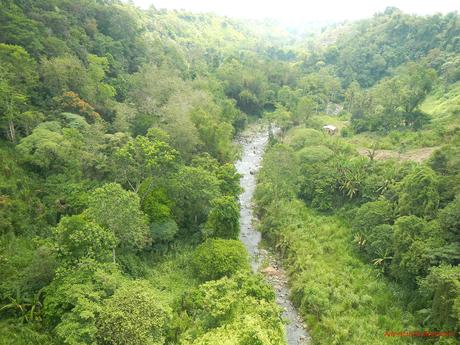
After 4 hours, we arrived at Valencia City where Mark and Donna runs their outdoor gear business. We also met Vincent Chan and Jboy Sanchez (not in the photo), two of our friendly and qualified guides. Right away, they prepared our equipment for tomorrow’s adventure.
You might ask, does it really take an entire day to prepare everything? Yes! Choosing the right gear, getting it to the site, hauling it on top of a cliff, and setting it up safely is a whole lot of work.
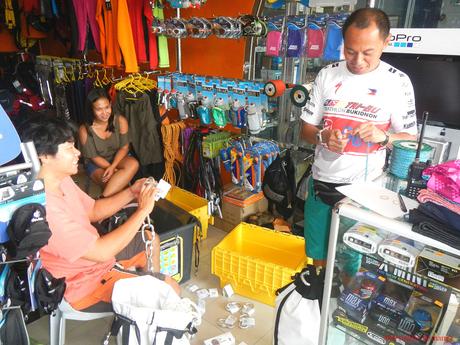
We took a break and had a simple yet hearty Filipino lunch at the restaurant right beside Adventure Technology Outfitters. This is one thing that is very nice in Valencia; the food is very affordable.
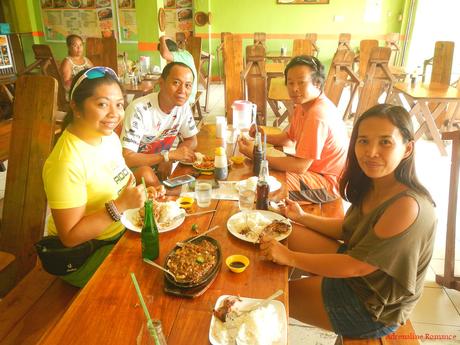
This high-tech contraption is a portable toilet. Yes, it works exactly like the toilet in your home except that it can be carried around. The waste is stored in the lower half of the unit while water for flushing is stored at the top. After doing your business, you simply push that accordion-like device to flush the waste down. Certain chemicals are added in the water to neutralize the smell.
Adventure Technology Outfitters plans to bring the portable toilet up to the bivouac ledge for the convenience of guests.
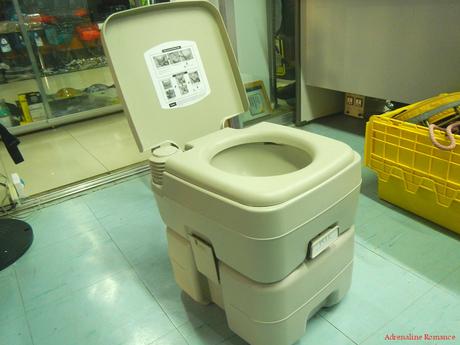
It took the entire afternoon to prepare the ropes, hardware, and radios. At last, at around 5 PM, all the necessary gear was ready. All we need to do now is to prepare ourselves.
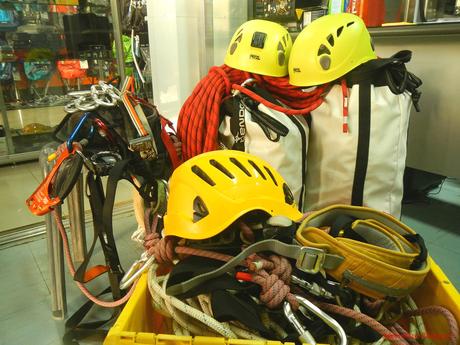
The next day, we drove to Quezon, Bukidnon, which is the site of our adventure. In less than an hour, we saw this enormous wall, which totally dominated the landscape. Just look at how huge that wall is!

Once we crossed the Pulangi Bridge at the border of Quezon, we enjoyed the full and uninterrupted view of the monstrous 550-foot Kiokong White Rock Wall. It’s a mammoth karst formation that has been formed millions of years ago.
The Kiokong White Rock Wall is so colossal that it could be made into the Philippine’s first big wall, a developed multi-pitch rock climbing that takes several days to ascend.
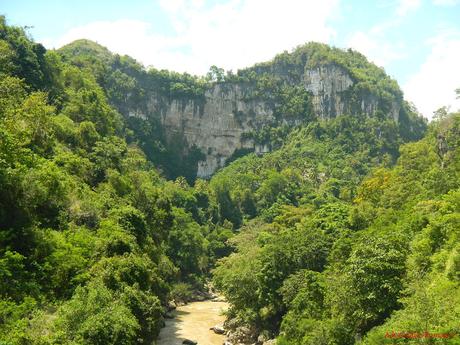
Not quite as high as that of the Atugan Bridge but impressive nonetheless, the Pulangi Bridge is a perfect venue for bridge jumping or rappelling. The brige is located at the border of Maramag and Quezon.

The roiling Pulangi River is powerful enough to dig up the silt under the river, making the water perpetually light brown in color. It is a potential venue for whitewater kayaking or water tubing. The entire extent of this river hasn’t been explored yet.

The LGU of Quezon has been very supportive of Mark and Donna’s endeavor. They have erected a parking lot, a briefing area for guests, and a shower room and toilet. They also have a visitor’s center where one can inquire, register, or book for the various adventures that will be offered here. Across the road are various stores where one can buy snacks and beverages.
Indeed, Kiokong is the ideal venue for a real, not commercial, adventure park.
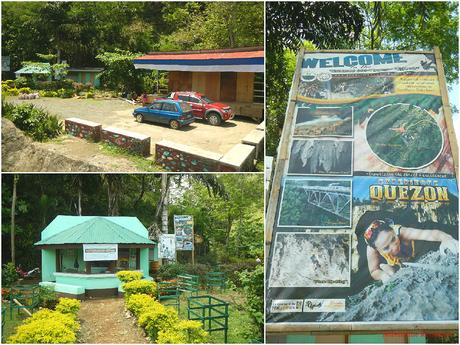
After introducing ourselves to the barangay workers there, we walked down the shady, well-established trail, which is used daily by local farmers and woodcutters.
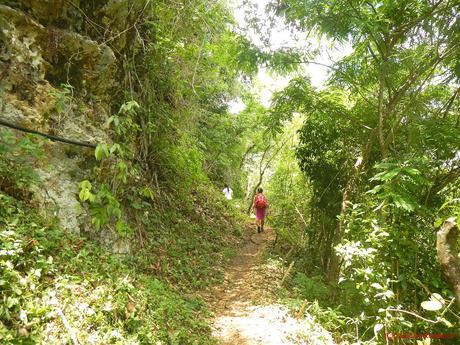
Much to our delight, this adventure site also features a small but well-bolted crag! That means, Bukidnon has a rock climbing site! More on this exciting crag later.
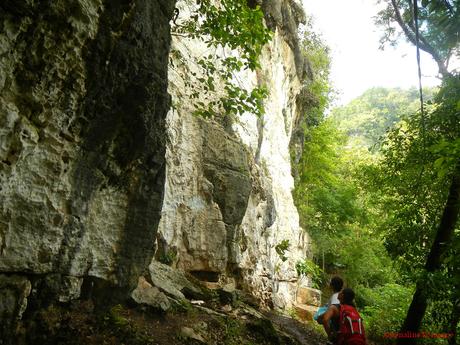
After a 10-minute walk, we arrived at a shady clearing where we found a nice table and bench made of bamboo. Donna told us that we were going to take our lunch here.
This nice area also serves as a campsite for those who want to spend the night here. It’s spacious enough to hold 20 to 30 tents.
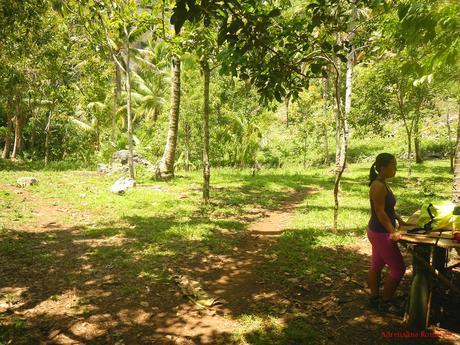
For the adventurer’s convenience, locals have set a clean pay toilet here where they can do their personal business. Fee is P5 per use.
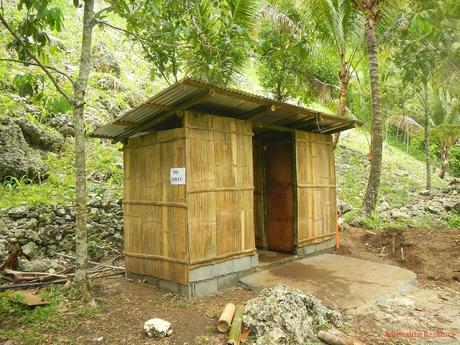
Right before us is the full glory of the titanic, pure limestone rock wall. But in addition to being a climbing site, it also has practical purposes.
The Kiokong White Rock Wall serves as a natural buffer for strong winds, protecting the lowlands from the brunt of storms. Also, being made of porous limestone, the rock wall is a natural aquifer, which filters and supplies potable drinking water in the surrounding areas.
See that second line just below the top of the cliff? That’s where we will bivouac for the night.
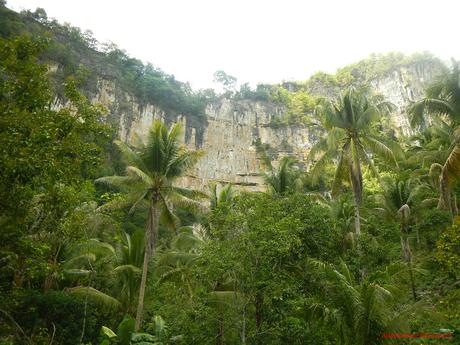
Here’s a closeup of our bivouac ledge. Just look at how tiny the guide (the person in the orange shirt and yellow helmet) is. In a few hours, we will be climbing towards that tiny, dizzingly high ledge which is 480 feet off the ground!
Take note that this photo is taken with the full zoom capability of my camera so that you’ll have an idea of just how high our ledge is and how huge this wall is.
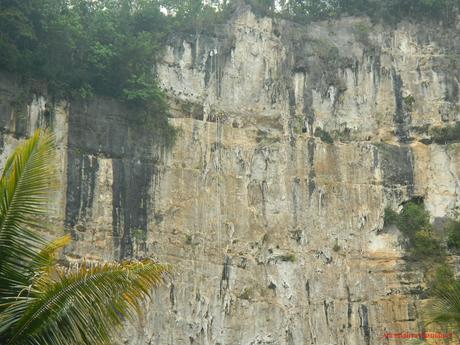
Those hardworking guides spent the entire morning hauling up the heavy gear to the top of the cliff and setting up the ropes. We reckon they must be tired and ravenous right now, so Donna radioed the guides that lunch was coming.
From the campsite (and still at full zoom), we saw the guides rappel down the cliff. The rock wall in the photo is just one quadrant of the entire karst formation. Just check out how tiny the guides are against this monstrosity.
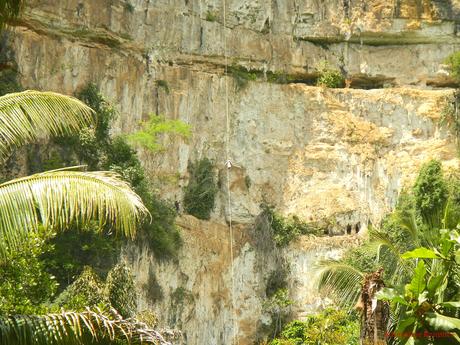
Mark, Sweetie and I went to base of the wall to greet the guides who were abseiling down the ground. The trail is adorned by huge, fat bamboo.
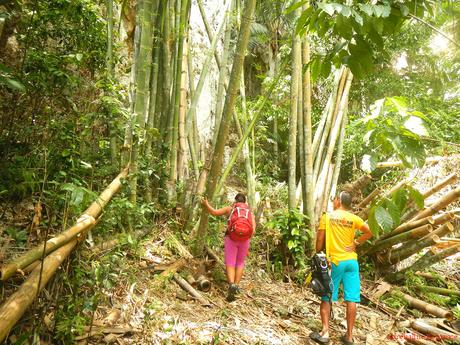
There they are although we could barely see them! Also, check out the high-quality of the limestone rock. Perfect for bolting, don’t you think?

This is our starting point, a large plateau-like geographical structure that is adorned with numerous large tufas and stalactites. You can also see a guide setting up anchor at the the lip of the plateau.
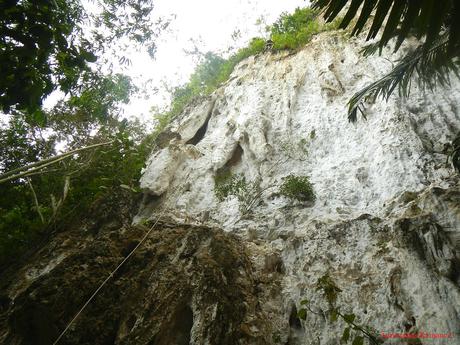
After everyone got down, we hurriedly went back to the camping area; our tummies were grumbling! We were treated to a humble but delicious lunch of locally prepared dish of inu-unan nga carpa (river carps, onions, and garlic boiled in native vinegar) and roasted chicken.
Oh, let us introduce you to this team of extremely skilled, trained, and competent guides: from left, that’s Donna, Donnie, Mark, Jboy, and Vincent. A while later, fellow blogger, traveler, and adventurer Tupe of Trekero joined us.

After a hearty lunch and suffering from a pleasant bout of SSB, we headed back to the parking lot to prepare ourselves and bring our personal equipment to the rock wall. This was our first time to use such climbing equipment, so Mark helped us set up our gear.
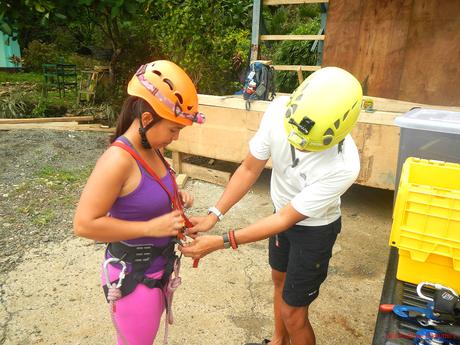
Here’s Sweetie, fully equipped with all the necessary gear for the ascent. Let’s check out all the equipment she’s wearing:
- A harness which acts as a portable seat. It serves as the main attachment point between Sweetie and a stationary object
- A Petzel Torse (the red suspender-like webbing) which helps bring Sweetie’s body closer to the rope
- A Petzel Croll (the orange gear attached to the harness and Torse) to lock her in place on the rope. In addition, using gravity and the weight of the rope, it also automatically takes up the slack as the climber goes up.
- A cow’s tail or lanyard (the rope that is tied on the belay loop) in which each end is attached to a locking carabiner. The cow’s tail is a lifeline and safety device; it lets Sweetie anchor herself to a piece of protection
- A climbing helmet with a headlamp attachment to protect her head from falling debris
- An ascender and foot tape, which is attached to her gear loop. As its name implies, the ascender is a mechanical device used to climb up a rope. The foot tape attaches to the harness and the ascender, giving Sweetie leverage as she climbs up.
All these systems work into one efficient and reliable process.
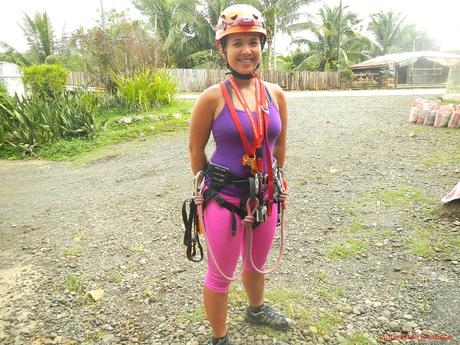
Below is a photo of an ascender. It moves freely when it is pushed up the rope. But when the climber pulls it down as he or she ascends the rope, it clamps down the rope using a camming action. The force is strong enough to hold a climber’s weight.
The ascender is attached to a foot tape, which the climber fastens around his foot. As the ascender is moved up, the foot tape brings the climber’s foot up as well. The climber then steps on that foot to move up the rope.

The Ascent
Check out this short humble video of our ascent. Looks really exciting, isn’t it?
All set? Let’s go! But before climbing, Vincent briefed us in detail on the purpose and how to properly use the extensive and high-tech climbing gear that each of us are about to use. He also explained the proper climbing techniques, safety protocols, and more.
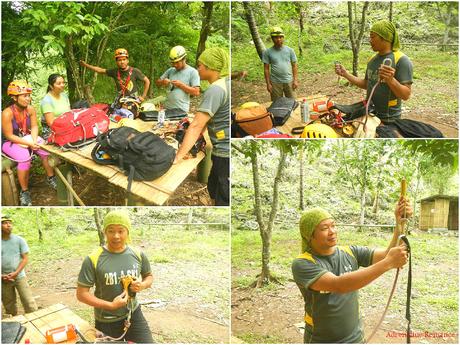
Mark first ascends towards the first ledge to rig two more lines so multiple climbers can ascend the rope. Once he reached the top, he pulled up the two extra lines and a bag full of extra gear.

The guides got a go signal from Mark that all the lines are secured. They gave us last-minute instructions and attached the croll and the ascender to the lines.
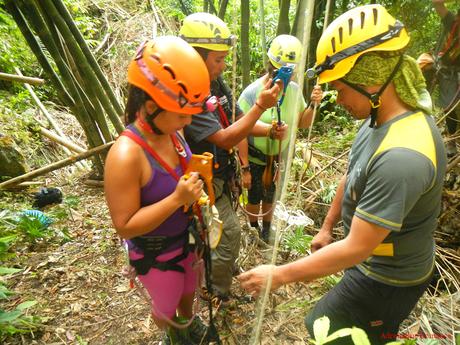
It was time for the grueling ascent! We used single rope technique (SRT); SRT, as the name implies, is a set of methods that are utilized to ascend and descend on a single rope.
We made use of top-quality static ropes in our ascent and descent. Unlike dynamic ropes which we use in rock climbing, static ropes are designed not to stretch when subjected to a load. This makes SRT-climbing easier and more efficient.
Just like rock climbing, you need a partner for extra safety. Thus, Sweetie and I as well as our guide Donnie were tethered to each other using our cow’s tail.
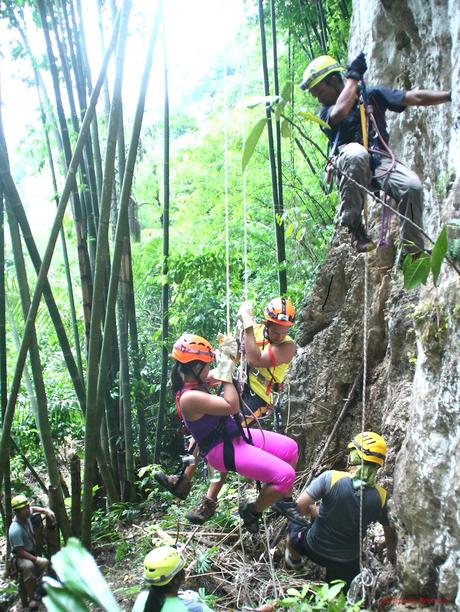
(Photo credit: Tupe Diaz)
The first 10 minutes of the ascent was quite awkward as we were quite new to the climbing technique. Soon, however, we established a steady and relaxing push-and-pull-and-step movement, which made the ascent easier and more enjoyable. Just check out Sweetie’s smile when she was able to adapt to the movement.
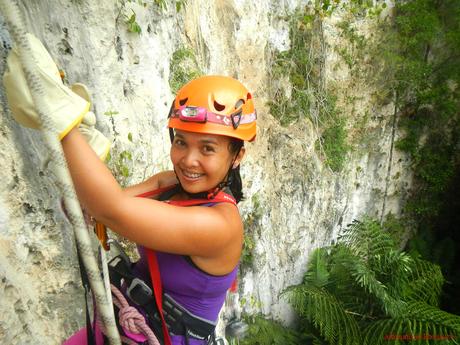
That’s the view at around 60 feet up! We were still halfway from the first part of our ascent, but we have already climbed as high as most of the single pitches in Cantabaco and Poog crags here in Cebu!
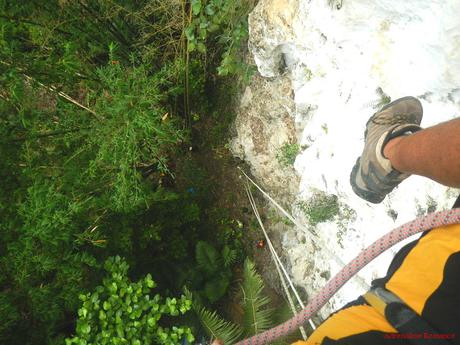
After 20 minutes of climbing, we reached the top of the first ledge, which is around 100 feet up the ground. Using a systematic process for utmost safety, we carefully detached ourselves from our lines and scrambled up a short but steep slope characterized by loose soil and rocks. No worries though because the guides fixed a safety line from the anchor to the ledge.
Sweetie underwent a more complicated process; her position requires her to disengage from her line and transfer to mine so she can access the slope.
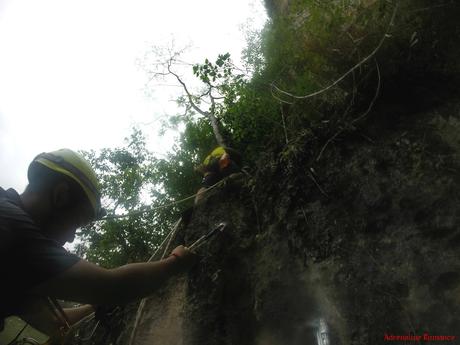
That’s the slippery slope that leads to the first ledge. We used our ascenders and cow’s tail for safety so we won’t slip back to the lip of the first ledge.
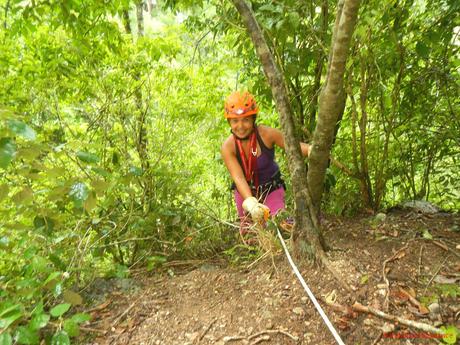
Just to give you an idea of just how high we are and how precarious our position is, check out the photo below. Can you imagine just how far we are off the ground? And this is just the first stage of the climb!
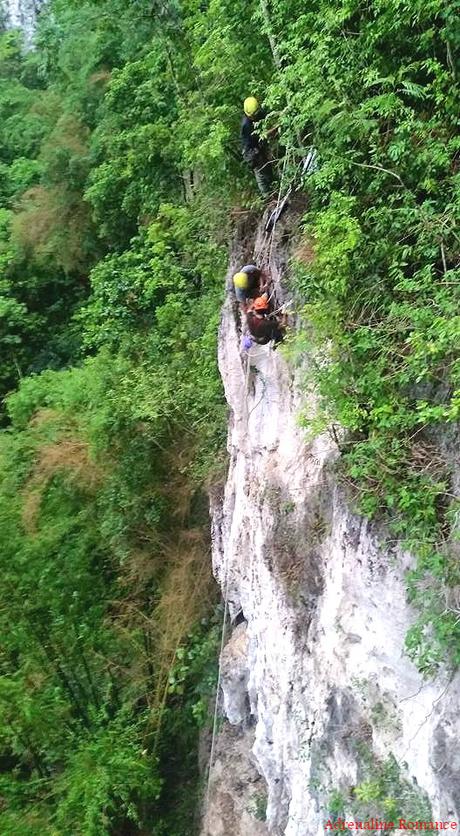
(Photo credit: Mark Battung)
One by one, each of us arrived at the first ledge, which offers a great view of the surrounding areas. The ledge is wide enough so that, with care, we can move around without having to attach ourselves to a safety line or anchor.
Also, check out the photo below. You can see the main rope lines for the main ascent. The lines had to be tethered close to the ledge because the Kiokong White Rock Wall is moderately overhanging. That means, the ropes hang straight down far from the rock face. Without tying them close to the ledge, it would be impossible to reach those lines.
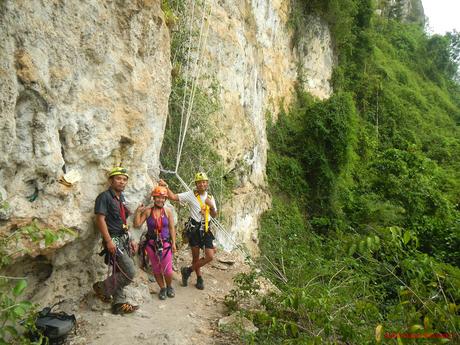
As the afternoon progressed, it began to rain. But we didn’t need to worry about the weather. The overhang protected us from the downpour like a natural roof. In fact, we were dry to the bone the whole time it was raining!
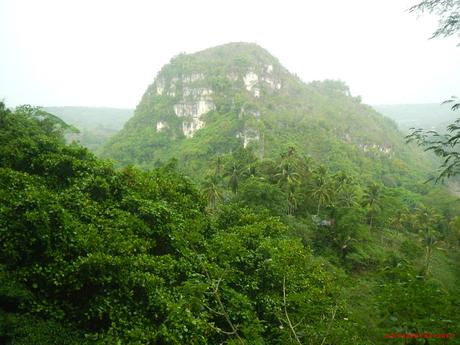
Moving forward toward the edges increases the risk of slipping and falling into the abyss. To mitigate the danger, we hook up to safety chains like this. The chains are fastened to properly bolted hangers, which is quite impossible to be yanked out of the rock.
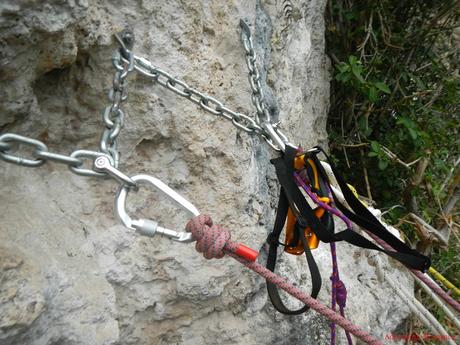
That’s how we secure ourselves. Check out sweetie’s cow’s tail. It is securely linked to the chain.
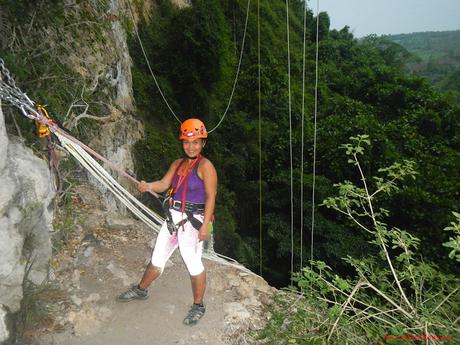
The first ledge is the perfect place for a re-belay. Re-belaying means to detach oneself from a line to transfer to another line. We have to re-belay because the main ropes can’t reach the groud.
Mark went ahead of us to another ledge so he can throw us a line to bring us closer to the wall.
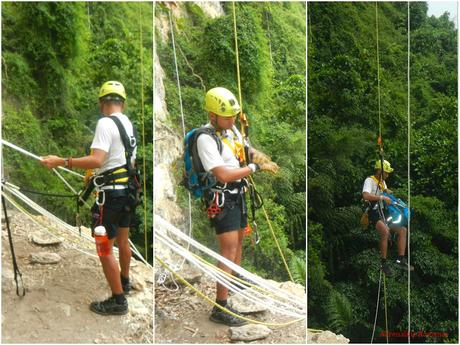
Up he goes! It’s a long way down and an even longer way up! Look at how far the ropes are from the rock wall.

While waiting for Tupe and the guides, we caught a glimpse of the pretty pink sunset in Bukidnon. That meant one thing: we were going to ascend at night!
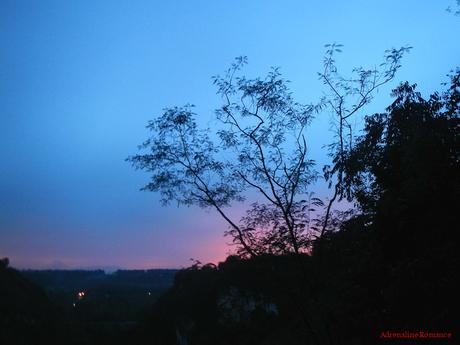
After the rest had a break, it was time to continue the ascent. We finished the re-belay procedures, swung out of the first ledge, and started ascending.
Here is Tupe going up the rope in darkness. Ascending in a black void was quite a strange feeling; we know that we are suspended up a deep abyss, but we can’t see how high we really are. It’s a strange mixture of calmness and anxiety.

After 20 long minutes of ascending, we arrived at this small and narrow transition ledge. The transition ledge is a stopover so climbers can rest and recover their strength. This prepares climbers for the main and longest part of the ascent.

That’s one of the hangers drilled into the rock. This serves as an anchor point for the guides.
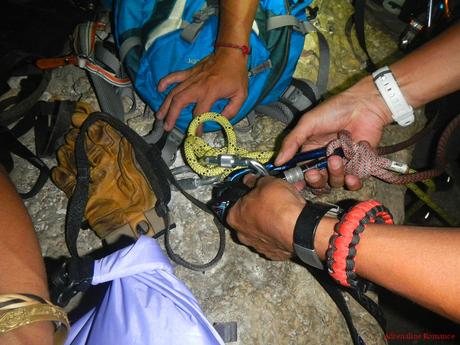
Sweetie and JBoy relaxed as they enjoyed the beauty of nothingness.

The “table” rock at the transition ledge has a small cavern below it. When we checked what’s underneath the rock, we found a number of small bone chips—from femurs to skulls. It turned out to be a sacred burial area of the local monkeys that sometimes scale the Kiokong wall. Amazing creatures, aren’t they?
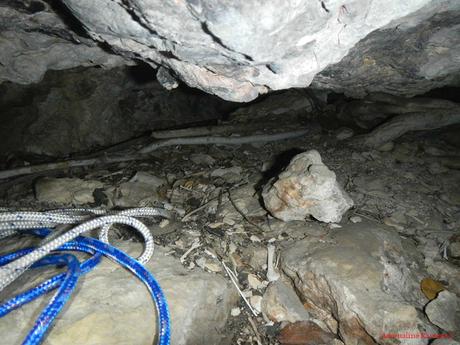
After 15 minutes, we started the main ascent. Check out the void below our guide Donnie. We can’t even see the bottom!
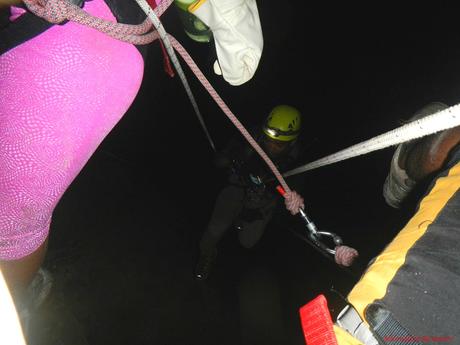
Finally, after almost an hour of climbing, we reached the bivouac ledge where we will spend the night. That ledge is 480 feet off the ground.
Donna and Vincent went ahead of us to set up mats and safety lines. They met us here and congratulated us for making it through the ascent. All in all, including the stops, it took 5 hours to complete the ascent.
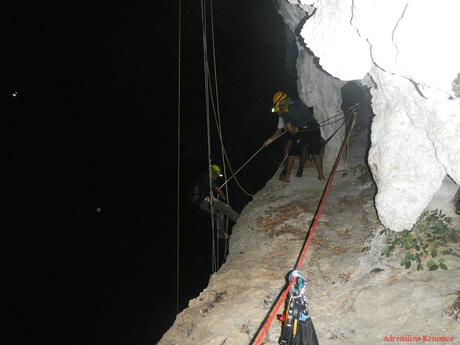
This was our hotel for the night. Quite amazing, isn’t it? We’re sleeping on a narrow, rocky ledge with a deep abyss right in front of us!
We celebrated our ascent with a light dinner of bread, bam-i (rice noodles sauteed with pork, garlic, onions, and peppers), and coffee.
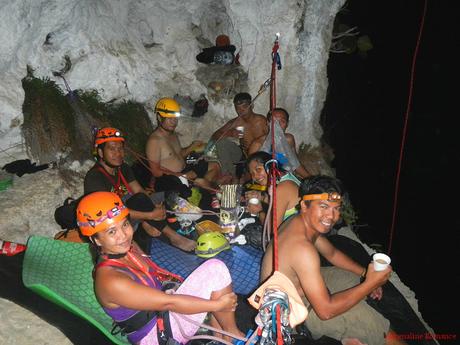
After dinner, it was time to socialize with the everyone. We laughed, shared stories, and drank juices (we didn’t bring any liquor). The pale beam of the full moon, which illuminated the night landscape in overwhelming majesty, was the main light source.
Some time later, heavy fog rolled in; according to Mark, it was the first time they’ve experienced the phenomenon. The entire landscape looked like a surreal, mysterious scene from an old vampire movie. Perfect for sharing scary stories if you’re into that sort of thing.

(Photo credit: Mark Battung)
At 10 PM, it was time to turn in and call it a day (or night). We pulled out our blankets and sleeping bags to ward off the chill and said took one last look at the fog-laden haven.
Watch out for Part 2
Contact Details
Adventure Technology Outfitters is the only entity offering the vertical bivouac adventure. Please contact Mark P Battung using the following contact details:
- Cellphone Numbers
* 0917-804-6009 – Globe
* 0930-613-1999 – Smart
* 0942-633-9642 – Sun
- Social Media
* Facebook: Mark P. Battung
* FB Page: Adventure Technology Outfitters
* Email: [email protected]
- Mailing Address
Adventure Technology Outfitters
Unit 1-2 Gabriel L. Alkuino Bldg.
Sayre Highway, Poblacion
Valencia City, Bukidnon
Please inform them in advance for bookings.
Rates
- Local Fee: P6,500.00 per pax
- Foreigner Fee: $200.00 per pax
A booking and reservation fee of P2,000 per guest is required with your balance upon arrival (reservation fee is non-refundable but transferable)
- Minimum Number of Guest: 5 (4 pax will be allowed on some occasions with adjusted rate)
- Maximum Number of Guests: 9 (10 pax and above, please contact Mark of Adventure Technology Outfitters )
Considering the difficulty of rigging the rope, hauling the equipment, acquiring the skill and certification required for this activity, using top-quality climbing equipment, and other factors, the rates are actually very good deals. Just to give you a reference, joining a similar activity in Yosemite, Patagonia, or similar places will cost you a thousand dollars for the guideship services alone. Yes, that’s excluding equipment.
And remember, this is the only one of its kind in the Philippines. This unique experience has more value than a mere few thousand pesos.
Inclusions
- transfers (see Part 2)
- climbing equipment and head lamp
- personal protective equipment (PPE)
- sleeping pads
- hauling bag for your belongings
- camp stove
- paper plates, utensil and cups
- sanitary equipment
- regulatory fee
- park fee
- guide fee
Notes
1. Rates are subject to change without prior notice (update will be posted).
2. Cancellation due to an unforeseen situation does not entitle you a full refund. However, you have the option to reschedule your adventure at no added charges.
3. If you insist on a refund, you will be charged 30% of the total cost of the activity.

